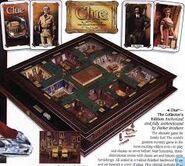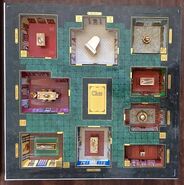Clue: Franklin Mint Edition is one of the rarest and most expensive Clue games out there. With playing pieces covered with 24 karat gold, and artwork by the famous Drew Struzan. In the game, Mr. Boddy (Mr. Black) was murdered in his ancestral country home, Hollinghurst Manor.
Hollinghurst Manor[]
Hollinghurst Manor is the home of the Boddy (Black) family. In each of the nine rooms is a gold piece of furniture.
- Hall: Table
- Lounge: Sarcophagus
- Dining Room: Dining Table
- Kitchen: Chopping Block
- Ballroom: Grand Piano
- Conservatory: Moorish Fountain
- Billiard Room: Billiard Table
- Library: Globe
- Study: Book stand
The Rooms of Hollinghurst[]
In the F.M. Edition, each room is given a detailed history with the past owners of Hollinghurst.
|
The Rooms: The Hall: Successive generations did not alter the design of this magnificent early Georgian room, but rather kept it in its original splendor and commissioned the restoration of the original blue deep-cut silk velvet damask that Kent designed for this room. KIent's classical architecturee is elegantly adapted for this Great Hall. He also designed a pair of settees (on the East Wall), four candelabra, and a tabble in the center of the room. Matthais Locke, another prominent furniture designer, supplied a pair of console tables (a similar example is in the Metropolitan Museum of Art, New York) on the North Wall. The portrait over the fireplace is of William Boddy, painted in 1734; he is flanked by portraits of his daughter Dorothy, on the left (she was the mistress of Hollinghurst from 1752-1775) and his son George (the future second earl of Hollinghurst). Family portraits adorn two of the other walls. On the pair of Locke consoles on the North Wall are a pair of Roman busts: Livia (c.75 A.D.) and Commodus (c. 123 A.D.). On the floor is one of the glories of French craftsmanship: a rare Savonnerie carpet originally made in 1740 for Louis XV, who rejected it because it was too small for his library. Lady Dorothy, who was a special friend of the French Queen, was able to acquire this treasure for Hollinghurst Manor. The Lounge: With the unusual flair for the theatrical and for appropriating architectural vocabulary from the Ancient World (Egyptian, Greek, and Roman), Hope designed one of his most successful rooms, the Lounge at Hollinghurst Manor, which survives intact from the early 1820s. A frieze containing Egyptian motifs runs around the room. The walls are covered with the original mustard-color silk, with matching drapery treatment covering the windows and doors. Most of the furniture in the room, which was designed by Hope, still survives: the four armchairs (North and South Walls), the sofa stool and end tables. Hope also designed the fireplace on the North Wall and the picture frame on the East Wall. The only piece that was purchased is the French Empire-style piano, which was acquired in Paris for Lady Emily. In a bit of whimsy, Hope designed Greek masks to be hung on the wall. These masks were connected to pipes through which Lady Emily could transmit sounds from her boudoir upstairs. This always succeeded in leaving her visitors terrified. Long before interest in Egyptian artifacts reached a fevered pitch, Lady Emily installed a gilt sarcophagus in the room to conceal the secret passage that leads to the Conservatory. The Dining Room: Through his alliance with the East India Company, William Boddy was able to amass an important collection of Asian ceramics and lacquer. This collection was augmented by successive generations, so that today the Hollinghurst collection of Eastern ceramics and lacquers is considered one of the finest private collections. Many of the original objects collected by the first Earl of Hollinghurst are still prominently displayed in this room. Most notable is the Japanese lacquer cabinet on an English gilt wood base placed against the North Wall. Flanking this ornate piece is a pair of monumental blue and white porcelain vases. A handsome porcelain charger rests atop the lacquer cabinet and another, smaller vase sits below. On the West Wall of the Dining Room is the Coromandel lacquer screen and an unusual 17-th century red lacquer trunk presented as a diplomatic gift to William Boddy. An elegant pair of Console tables have been placed on the East Wall, each below an ornate gilt-framed mirror. Besides the portrait of William Boddy above the fireplace, the room is also the setting for several ancestral portraits painted in the academic tradition of British portraiture exemplified most notably by Sir Joshua Reynolds and the Royal Academy artists. The Kitchen: The cast-iron range was installed in the massive walk-in-fireplace on the West Wall. On the left side is an arcaded nook for storage of coal, wood and miscellaneous items for cooking: on the right, in another arcaded nook, are some of the kegs from the wine cellars of Hollinghurst. Like the Rothschilds, Mr. Boddy owns several vineyards in the Bordeaux region of Southern France which produce the famous Chateau Coquelicot wines. The North and East Walls have pedimened sideboards filled with chinaware cabinets filled with copper pots and pans. Te famrs at Hollinhurst keep the Kitchen well stocked with the basic neccessities to prepare a lavish feast - cuts of chicken, rabbit, beef and lamb are displayed on the East Wall and vegetables and fruits fill the kitchen tables. In the center of the Kitchen sits a massive work table hewn of English oak taken from the forests that lie to the east of Hollinghurst Manor. On the table, nicked and scarred by years of use as a chopping, slicing and butchering surface, can often be found a variety of knives, cleavers and skewers kept honed to a keen sharpness. Hollinghurst Manor has a permanent kitchen staff, most of whom have been in the Boddy's employ for two generations. This staff is greatly augmented when Mr. Boddy hosts parties or more than twenty guests. The Ballroom: The present Ballroom is exactly the way Lord Nigel left it when work was finished in 1865. The gold and white color scheme has yellowed a bit over the years but still sparkles brightly when all the lights are turned on and the mirrors reflect the gold and crystal in the room. Mirrors were also placed in the transoms above the doors. The furniture, as in the Salon d'Or et Blanc, is in the Louis XV style. The set of chairs was made in the late 1860s by Wright & Mansfield. Wall lights are applied to the pilasters that separate the arched elements throughout the rooms. The grand piano in the center of the room was specifically made for this room. However, the masterpieces of this sumptuous Ballroom is the fireplace and the elaborate overmantle mirror. It was carved by Italian artisans and faithfully replicates the fireplace at the Louvre. The white marble fireplace surround is supported by carved and gilt figures on each side holding elabborate candelabra. The coat of arms of the Hollinghursts is in the cartouche above the mirror surrounded by the symbols of glory. The Conservatory: Using pre-fabricated cast-iron parts supplied by the firm of William Cooper & Co., the two exterior (North and East) walls of the original Game Room of 1665 were demolished and two glazed walls in the Gothic revival style were erected circa 1856. Exoticism andd fantasy were in order for this room. Sir Nigel had traveled extensively, especially to Turkey and the Far East. He filled this room with some prized acquisitions from his trips: the Ottoman stained glass which was placed in clerestory windows, the tiled niches inspired by Islamic tiles from the Alhambra, the Burmese carved settee placed against the West Wall and the Chinese Red jardinieres. But most impressive of all is the elaborate tile work that covvers all the walls of the Conservatory. William de Morgan (1839-1917) was commissioned to design tiles in imitation of Turkish Isnck tile work. De Morgan produced the present tiles and went on to design numerous wares based on this commission for which he is world renowned. The Billiard Room: The North Wall is dominated by a recessed nook with elevated seating area and fireplace, which provides a great space for watching the games. Above the fireplace hangs an 18th-century painting of a view of a room purchased in the 1760s by Lord George Boddy, the second earl of Hollinghurst, during his Grand Tour. The Library: In each place he went, Lord George made it a point to visit the greatest thinkers, artists, and writers of the day - even spending a fortnight with Voltaire on his estate that straddled the border between France and Switzerland. Upon his return in 1766, Lord George commissioned Robert Adam (1728-1792) to design a new library to house the numerous books that he purchased on the Grand Tour. Included among these are the Persian tales of Montesquieu, the first ten volumes of Diderot's Encyclopedie, Lessing's Nathan the Wise and several anonymous tractys that everyone ascribed to Voltaire. Adam undertook this project with great zest and produced one of his trademark designs that was to be imitated in future projects. In the frieze area, Adam designed niches for ancient Greek marbles that Lord George had brought back with him from excavations in Greece. Interspersed between these ancient gods are the busts of some of the great thinkers of the time, such as Newton and Galileo. On the South Wall is the neo-classical fireplace with a Greek subject paiting of Alexander the Great examining the work of the great painter Apelles, painted by Angelica Kauffman. The suite of four sofas and four armchairs designed by Adam still maintain their original fabric with gold embroidery. The carpet is one of the few surviving carpets that were executed after a design by Adam. As with many of his later projects, the carpet design reflects the plaster design he created for the ceiling. At the center of the room stands a massive globe, reflecting perhaps, the wide scope of Lord George's interests. The Study: For his collection of fossils, gems and insects from around the world, Lord Alexander needed an appropriate setting designed in the most rarefied style of the 1870s: the Aesthetic Movement. He appropriately hired Richard Norman Shaw, who designed the highly functional and beautifully simple display cabinets. Above the high dado, the walls are covered in a fabric which terminates in a segmented attic section made up of painted gold-ground panels. Alexander Boddy was patron to many artists, designers and writers of the period, e.g., Dante Gabriel Rossetti, William Morris, and Oscar Wilde. His proximity to the artistic movements of the time is evidenced by the several Pre-Raphaelite paintings commissioned by Lord Alexander, which hang on the walls. Among the other commissions in this room is the cabinet on the West Wall by Christopher Dresser on which is displayed a variety of contemporaneous ceramic vvessels. The area rug was designed by William Morris; Thomas Jekyll designed the intricate bronze fireplace with its overmantle unit that holds more ceramic vessels by many of the leading designers of the day. On the elegant lectern rests Lord Alexander's first edition of On the Origin and Metamorphoses of Insects by Sir John Lubbock, first baron of Avebury. Sir John and Lord Alexander were classmates at Eton and their friendship continued throughout the years, cemented, no doubt, by their mutual interest in understanding the world of insects. |

